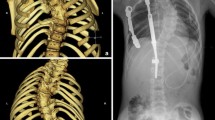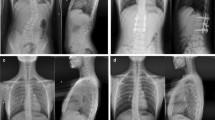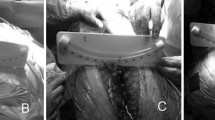Abstract
Purpose
To evaluate the effect of a vertical expandable prosthetic titanium rib (VEPTR) on head tilt in patients with congenital scoliosis.
Methods
Twelve Patients with fused ribs, congenital scoliosis (CS), thoracic insufficiency syndrome (TIS), and cervical tilt were treated with VEPTR open wedge thoracostomy. The Cobb angles of the primary thoracic curves were measured. Preoperative measurements of cervical tilt angle, first thoracic (T1) oblique take-off angle, head decompensation, and shoulder horizontal angle were all measured. All the patients were treated with VEPTR open wedge thoracostomy.
Result
There was statistically significant improvement in thoracic Cobb angle. At the end of follow-up there was significant improvement in the shoulder horizontal angle from 14.4° to 6.7°. Head decompensation had improved to ≤2 cm in nine patients. Both thoracic oblique take-off angle and cervical tilt angle had improved from 35.1° to 33.9° preoperatively to 30° and 27.2° at the end of follow-up. Complications included device migration (one patient) and pedicle screw loosing (one patient).
Conclusion
VEPTR is able to stabilize head tilt in patients with congenital scoliosis.


Similar content being viewed by others
References
Campbell RM Jr, Adcox BM, Smith MD et al (2007) The effect of mid-thoracic VEPTR opening wedge thoracostomy on cervical tilt associated with congenital thoracic scoliosis in patients with thoracic insufficiency syndrome. Spine 32:2171–2177
Campbell RM Jr, Hell-Vocke AK (2003) Growth of the thoracic spine in congenital scoliosis after expansion thoracoplasty. J Bone Joint Surg Am 85:409–420
Campbell RM Jr, Smith MD, Mayes TC et al (2003) The characteristics of thoracic insufficiency syndrome associated with fused ribs and scoliosis. J Bone Joint Surg Am 85:399–408
Campbell RM Jr, Smith MD, Mayes TC et al (2004) The effect of opening wedge thoracostomy on thoracic insufficiency syndrome associated with fused ribs and congenital scoliosis. J Bone Joint Surg Am 86-A:1659–1674
Deburge A, Briard J (1981) Cervical hemivertebra excision. J Bone Joint Surg Am 63:1335–1339
Dubousset J (1986) Torticollis in children caused by congenital anomalies of the atlas. J Bone Joint Surg Am 68:178–188
Emans JB, Caubet JF, Ordonez CL et al (2005) The treatment of spine and chest wall deformities with fused ribs by expansion thoracoplasty and insertion of vertical expandable prosthetic titanium rib. Spine 30(suppl):58–68
Fisk JR, Winter RB, Moe JH (1980) The lumbosacral curve in idiopathic scoliosis. J Bone Joint Surg Am 62:39–46
Hasler CC, Mehkens A, Hefti F (2010) Efficacy and safety of VEPTR instrumentation for progressive spine deformities in young children without rib fusions. Eur Spine J 3:400–408
Hell AK, Campbell RM Jr, Hefti F (2005) The vertical expandable prosthetic titanium rib implant for the treatment of thoracic insuffiency syndrome associated with congenital and neuromuscular scoliosis in young children. J Pediatr Orthop B 14:287–293
Hensinger RN (1991) Congenital anomalies of the cervical spine. Clin Orthop 264:16–38
Kamerlink JR, Engel I, Wardhan AP et al (2010) The treatment of vertebral and chest wall deformities with expandable thoracoplasty and a prosthetic expandable implant. J Pediatr Orthop 30:90–98
KlemmeWR Denis DF, Winter RB et al (1997) Spinal instrumentation without fusion for progressive scoliosis in young children. J Pediatr Orthop 17:734–742
Letts R, Bobechko W (1974) Fusion of the scoliotic spine in young children. Effect on prognosis and growth. Clin Orthop 101:136–145
Ruf M, Jensen M, Harms J (2005) Hemivertebra resection in the cervical spine. Spine 30:380–385
Schwender JD, Denis F (2000) Coronal plane imbalance in adolescent idiopathic scoliosis with left lumbar curves exceeding 40°: the role of the lumbosacral hemicurve. Spine 25:2358–2363
Tsirikos AI, McMaster MJ (2005) Congenital anomalies of the ribs and chest wall associated with congenital deformities of the spine. J Bone Joint Surg Am 87:2523–2536
Winter RB, Moe JH, Lonestein JE (1984) Posterior spinal arthrodesis for congenital scoliosis. J Bone Joint Surg Am 66:1988–1997
Conflict of interest statement
No funds were received in support of this work. No benefits in any form have been or will be received from a commercial party related directly or indirectly to the subject of this article.
Author information
Authors and Affiliations
Corresponding author
Rights and permissions
About this article
Cite this article
Samy, M., Zayed, Z.A. What to expect postoperatively with respect to head tilt in congenital scoliosis. Eur J Orthop Surg Traumatol 21, 1–5 (2011). https://doi.org/10.1007/s00590-010-0659-8
Received:
Accepted:
Published:
Issue Date:
DOI: https://doi.org/10.1007/s00590-010-0659-8




